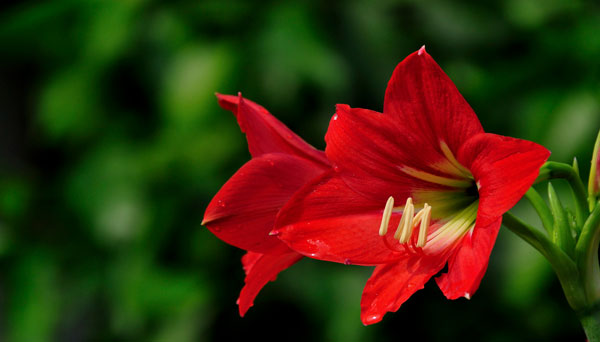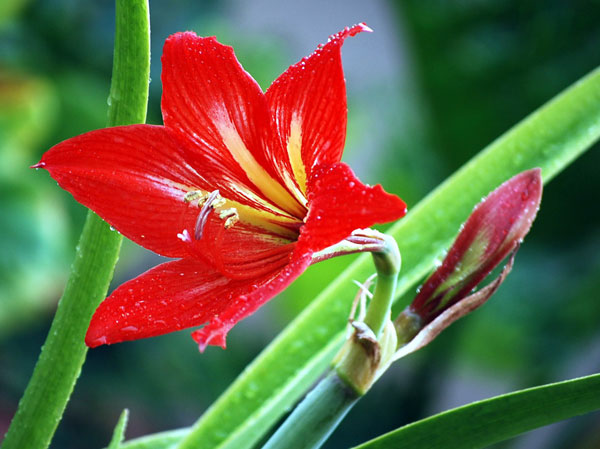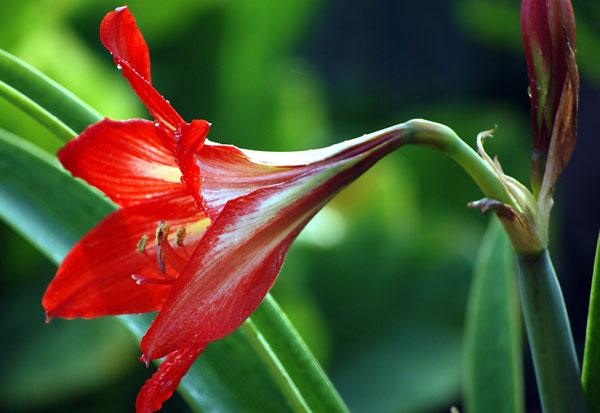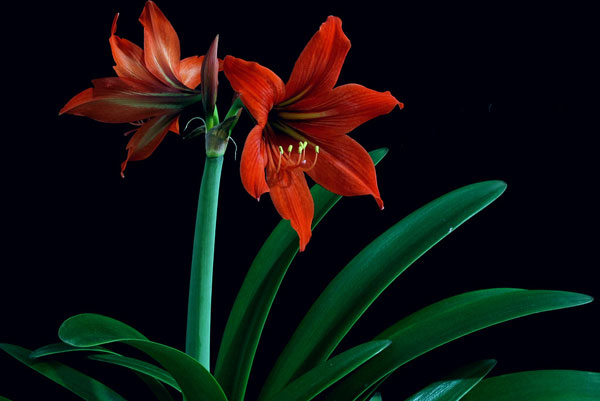Amaryllis (Hippeastrum) Care & Propagation Guide
Written by Iris
Oct 13 2021

Blooming Amaryllis (Hippeastrum) are a spectacular addition to any garden or bouquet. Amaryllis (Hippeastrum) is originated in tropical regions such as the Caribbean, South Africa or the islands of the South China Sea, amaryllis can be found all over the world, except Antarctica. Each plant is bred from two plants, and each flowering flower is two to five flowers with an average lifespan of six weeks.

Sow seed as fresh as possible in spring in free draining seed compost
Maintain a temperature of 21°C (70°F)
Start feeding with a general pot plant feed five to six weeks after germination, until September
Grow in individual small pots, potting on periodically during the spring and summer into slightly larger pots each time the pot becomes well filled with roots
Keep the Amaryllis plants growing actively in moderate warmth and do not induce dormancy (do not drop the temperature as for inducing flowering)
Both loose and pre-potted bulbs are available for indoor forcing, or outdoor sowing in warm areas.
Once dormancy is broken, it takes between six and eight weeks for flowering to occur.
Offsets are bulblets, or “daughters,” that grow alongside a large “mother” bulb. They are broken away from the mother to start new plants and reduce crowding.
The larger the offset, the better, because they take from two to five years to bloom, depending upon their size. The best time to divide is in late fall, but for those in warm regions, it is also possible to divide in late winter. Offset division produces plants with the same characteristics as a parent plant.
A Amaryllis bulb can be dug up and cut into sections to create new plants. This is a common commercial practice, also known as twin scaling. The best time to do this is after a bulb has bloomed and grown foliage, but before the leaves fade and dormancy begins. It's done by removing the brown “tunic” and dividing the bulb like a pie, with multiple sections that each contain a bit of outer scale and basal plate, the bottom where the roots are attached.
The sections are cut and then treated with a fungicide before being planted in a moist, sterile potting medium. Sections may begin to regrow in one to three months, but it may take two or more years before they flower.
Neither Hippeastrum or Amaryllis are very fussy about humidity. But remember that very humid locations will need less watering overall than locations which are very arid because the potting soil will take longer to dry out.
The narcissus bulb fly may lay its eggs in the bulbs of amaryllis plants that are placed outdoors for the summer. Because control is difficult, it is best to destroy any infested bulbs as soon as the narcissus bulb fly is identified. The use of insecticides is generally ineffective.
Red blotch (Stagonospora curtissi) is a fungus disease that may affect both the appearance and the health of amaryllis plants. However, this disease is not usually fatal to the plant.
Buy healthy bulbs. Carefully inspect amaryllis bulbs before purchasing and do not purchase damaged bulbs or bulbs with cankers.
Plant bulbs in a clean container with sterile, new potting soil.
Wipe pruners and stakes used on infected plants with alcohol.
Care for plants properly.
If the disease persists, the bulbs may be treated with a systemic fungicide.
'Samba': This variety has large red ruffled blooms with white markings.
'Apple Blossom': This popular variety has blooms that mix pink and white, with green throats.
'Faro': This plant has delicate flowers in pale salmon and white. The blooms are smaller and more delicate than with most varieties.
'Summertime': This plant has large 7-inch blooms in a unique watermelon pink to dark rose hue, with greenish centers.
'Matterhorn': This is a good choice for a pure white amaryllis. The throats are yellow-green.
Where to Grow Amaryllis (Hippeastrum)When to Grow Amaryllis (Hippeastrum)How to Grow Amaryllis (Hippeastrum)Amaryllis Propagation with SeedsAmaryllis Propagation with Bulb offsetsHow to Care for Amaryllis (Hippeastrum) Amaryllis Care - LightAmaryllis Care - SoilAmaryllis Care - WaterAmaryllis Care - Temperature & HumidityAmaryllis Care - FertilizerAmaryllis Care - PruningAmaryllis Care - Pests & DiseasesVarieties of Amaryllis (Hippeastrum)Amaryllis Plant Care FAQCan I use the Amaryllis blooms as cut flowers?How many flower stalks will my Amaryllis bulb produce?Is Amaryllis Poisonous?
Where to Grow Amaryllis (Hippeastrum)
Native to subtropical regions of the Americas, Amaryllis are best grown as a house plant here in the British Isles. Choose a bright spot away from drafts and out of direct sunlight.When to Grow Amaryllis (Hippeastrum)
If Amaryllis planted during in late autumn or winter, hippeastrum bulbs normally sprout within days, but then tend to struggle to grow well because of the low light levels at that time of year. It's best to keep the bulbs in a frost-free place after buying and plant in February when the emergence of foliage coincides with increasing day length.
How to Grow Amaryllis (Hippeastrum)
Amaryllis Propagation with Seeds
Seed-raised hippeastrums can take up to six years to reach maturity and flower. They will also usually differ from the parent plant.Sow seed as fresh as possible in spring in free draining seed compost
Maintain a temperature of 21°C (70°F)
Start feeding with a general pot plant feed five to six weeks after germination, until September
Grow in individual small pots, potting on periodically during the spring and summer into slightly larger pots each time the pot becomes well filled with roots
Keep the Amaryllis plants growing actively in moderate warmth and do not induce dormancy (do not drop the temperature as for inducing flowering)
Amaryllis Propagation with Bulb offsets
The easiest way to propagate a Amaryllis plant is with a dormant bulb.Both loose and pre-potted bulbs are available for indoor forcing, or outdoor sowing in warm areas.
Once dormancy is broken, it takes between six and eight weeks for flowering to occur.
Offsets are bulblets, or “daughters,” that grow alongside a large “mother” bulb. They are broken away from the mother to start new plants and reduce crowding.
The larger the offset, the better, because they take from two to five years to bloom, depending upon their size. The best time to divide is in late fall, but for those in warm regions, it is also possible to divide in late winter. Offset division produces plants with the same characteristics as a parent plant.
A Amaryllis bulb can be dug up and cut into sections to create new plants. This is a common commercial practice, also known as twin scaling. The best time to do this is after a bulb has bloomed and grown foliage, but before the leaves fade and dormancy begins. It's done by removing the brown “tunic” and dividing the bulb like a pie, with multiple sections that each contain a bit of outer scale and basal plate, the bottom where the roots are attached.
The sections are cut and then treated with a fungicide before being planted in a moist, sterile potting medium. Sections may begin to regrow in one to three months, but it may take two or more years before they flower.

How to Care for Amaryllis (Hippeastrum)
Amaryllis Care - Light
Bright light with some sun for part of the day is a must for your Hippeastrum if you are hoping for a repeat flower display next year. Too little light during the flowering period will also result in the stalks bending towards light sources and increasing the chances of it falling over.Amaryllis Care - Soil
Amaryllis need rich and exceptionally well-drained soil, so create a mix from 1 part well-rotted manure, 1 part horticultural grit or sand, and 2 parts leaf mould. Two parts good compost mixed with 1 part grit also does fine. Amaryllis have a tendency to rot, so good drainage is vital.Amaryllis Care - Water
Amaryllis (Hippeastrum) are easily overwatered, which will cause the bulbs to rot. To prevent this, always irrigate from above using tepid water. Avoid getting the nose of the bulb wet, and never allow your plant to stand in water. As a precaution, allow the top 2cm of compost to dry out before watering again.Amaryllis Care - Temperature & Humidity
When you first get your Hippeastrum, if it's not already in bloom or showing flowering shoots then you need a warm location to get things moving. Warmth along with a little moisture will awaken a dormant bulb and then if you keep it warm you'll have flowering shoots heading for the ceiling in no time. Neither Hippeastrum or Amaryllis are very fussy about humidity. But remember that very humid locations will need less watering overall than locations which are very arid because the potting soil will take longer to dry out.Neither Hippeastrum or Amaryllis are very fussy about humidity. But remember that very humid locations will need less watering overall than locations which are very arid because the potting soil will take longer to dry out.
Amaryllis Care - Fertilizer
Feeding is essential. Use a liquid fertiliser twice a month when in flower. After flowering is completely over, continue to feed the plant for 6 weeks if you plan to store the bulb.Amaryllis Care - Pruning
When the flowers fade, cut the flower stalk back to just above the bulb. Keep watering the plant until it goes dormant in the fall. You can move the amaryllis outdoors for the summer, placing it in a part-shade location.Amaryllis Care - Pests & Diseases
Although there are several insects, mites and diseases that may attack amaryllis plants under greenhouse conditions, they are not as common on amaryllis grown in homes. Careful inspection when purchasing bulbs accompanied by proper care will prevent most insect infestations as well as diseases.The narcissus bulb fly may lay its eggs in the bulbs of amaryllis plants that are placed outdoors for the summer. Because control is difficult, it is best to destroy any infested bulbs as soon as the narcissus bulb fly is identified. The use of insecticides is generally ineffective.
Red blotch (Stagonospora curtissi) is a fungus disease that may affect both the appearance and the health of amaryllis plants. However, this disease is not usually fatal to the plant.
Buy healthy bulbs. Carefully inspect amaryllis bulbs before purchasing and do not purchase damaged bulbs or bulbs with cankers.
Plant bulbs in a clean container with sterile, new potting soil.
Wipe pruners and stakes used on infected plants with alcohol.
Care for plants properly.
If the disease persists, the bulbs may be treated with a systemic fungicide.

Varieties of Amaryllis (Hippeastrum)
There are dozens of different amaryllis varieties, and the choice really depends on what flower color most appeals to you. Some recommended choices include:'Samba': This variety has large red ruffled blooms with white markings.
'Apple Blossom': This popular variety has blooms that mix pink and white, with green throats.
'Faro': This plant has delicate flowers in pale salmon and white. The blooms are smaller and more delicate than with most varieties.
'Summertime': This plant has large 7-inch blooms in a unique watermelon pink to dark rose hue, with greenish centers.
'Matterhorn': This is a good choice for a pure white amaryllis. The throats are yellow-green.

Amaryllis Plant Care FAQ
Can I use the Amaryllis blooms as cut flowers?
Yes! Amaryllis are becoming popular cut flowers, and, surprisingly, they often last longer in a vase — up to two weeks! — than they do when left growing on the plant. Instead of relegating a tall amaryllis to a windowsill or sideboard, you can create a dramatic dining table centerpiece by using a relatively low vase and combining your amaryllis blooms with other flowers and foliage.How many flower stalks will my Amaryllis bulb produce?
This depends on the variety of amaryllis, and the quality and size of the bulb. In general, the larger the bulb (for the particular variety) the more flower stalks you'll get. When it comes to amaryllis bulbs, bigger is better.Is Amaryllis Poisonous?
There are toxic compounds within this plant, and although they are sparse in the stem, leaves and flowers they are quite concentrated in the bulb. You should be careful if you've inquisitive pets.Latest Updated
- Benefits of Bugleweed - 7 Science-backed Health Benefits
- Bugleweed Dangers & Side Effects - Is It Poisonous?
- How to Plant Evergreen Trees - What You Should Know
- When to Plant Evergreens - Grow Guide for Evergreen Trees
- 12 Wonderful Evergreen Shrubs for Your Garden
- 12 Popular Evergreen Plants with Pictures for Beginners
- When And How To Prune A Lilac Bush Like a Pro
- How to Grow & Care for Lilac Vine (Hardenbergia Violacea)
- Japanese Lilac Tree (Syringa Reticulata) Care & Propagation Guide
- Shumard Oak Pros and Cons - What to Know
Popular Articles
- Winter maintenance of Antirrhinum Majus
- How to Grow Terminalia Mantaly Tree
- How to Grow and Care for Crossostephium Chinense
- How to grow Antirrhinum Majus in spring
- Peristeria Elata (Dove Orchid) Profile: Info & Care Guide
- Underwatered Snake Plant (Sansevieria Trifasciata) - Signs And How To Fix
- How to Care for Brazilian Jasmine Plant (Mandevilla Sanderi)
- How to Grow & Care for Graptopetalum Purple Delight in Summer
- Rosa Chinensis (China Rose): Plant Growing & Care Tips
- How to Care for Baby Sun Rose (Aptenia Cordifolia)